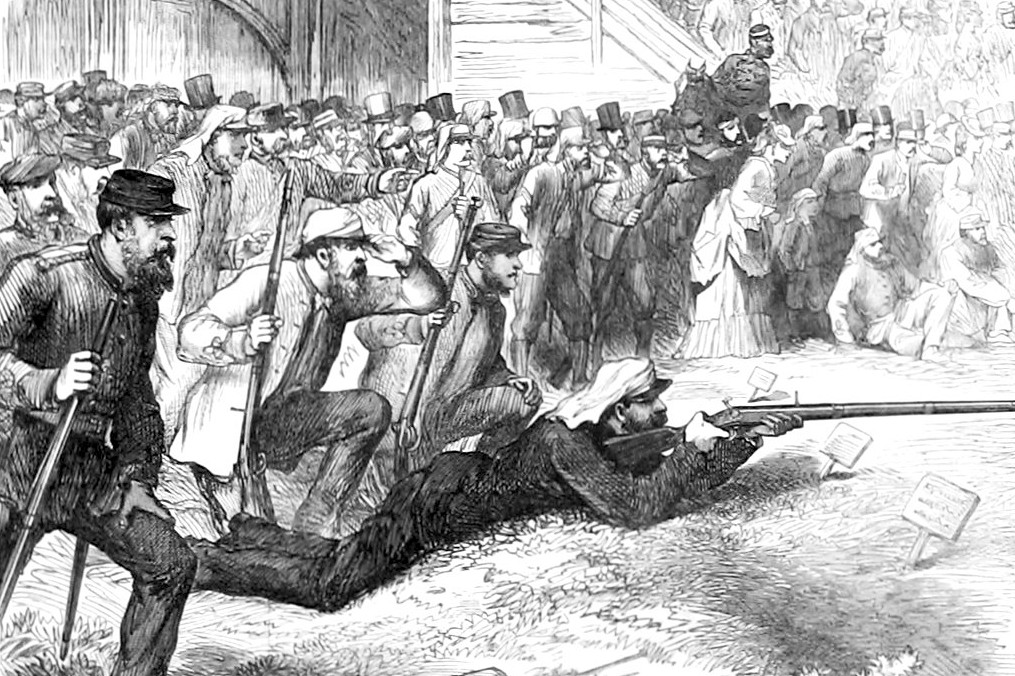You are here: Home > Firearms > Long Range Rifle Fire
Written by: Hap Rocketto
Introduction > Revolutionary Wars > Cap & Ball > Civil War & Whitworth Rifles > Mountain Men & Hunters > International Competition > Smokeless Powder > Post WWII
Long range is, by definition, a relative term. When the earliest European settlers arrived on the east coast of what would become the United States of America they were armed with a collection of match, wheel lock, and snaphaunce actuated firearms that were, occasionally, more dangerous to the user than the intended victim. Among the immigrants were gentlemen adventurers on the prowl for quick riches, families looking to build a new life, and others who sought religious freedom; all who drilled with these firearms under the under the leadership of the likes of Captain John Smith, in the Virginias, and Captain Myles Standish, in the Plymouth Colony.
The separatist Puritans came from England and, with the possible exception of one or two men, had never used firearms. Firearms were a tool of the soldier and a plaything of the aristocracy, hunting being forbidden to the common man. As much as the Pilgrims might have impressed the natives with the flames, explosive sounds and rolling smoke, they were far from effective marksmen. Even with a generous supply of powder, ball, and time to exercise themselves with their 16th and 17th century firearms, it took almost two years for the Pilgrims to become proficient. However, by the time they learned to hit what they aimed at, a hunting party of four could bring home enough game to feed the village for a week. Whether this is a comment upon the developing skill of the Pilgrim marksman or the quantity of game is left to the reader. In the early days of settlement long range might mean a distance of as much as 50 yards. The enduring myth that every American boy can drill out a gnat’s eye at 100 paces was in the making.
As time passed, gunsmiths from continental Europe immigrated to the New World and set up shop. They brought a tradition of manufacture and knowledge that was soon adapted to the technical and economic realities of the colonies. The somewhat clumsy and large calibre rifles of Germany, Austria, and Switzerland underwent evolutionary changes in the Lancaster region of Pennsylvania in the early 1700s at the hands of French Huguenot, Swiss and German craftsmen. The first American made rifles were manufactured in smaller calibres than its European antecedents to save precious lead and powder. The spherical bullet, between .32 and .45, weighed about 160 grains. The powder charge, of about 60 or 70 grains, left a minimum amount of fouling. The long barrel, about 40 inches, increased velocity making efficient use of powder and ball, as well as dampening the sound of the shot that might attract uninvited attention from four footed quarry or two footed enemy.
The rifle was equipped with what was the most reliable ignition system of the time-the flintlock. It had brass furniture and a recess built into the butt to hold a supply of grease or greased patches. Called a patch box, this is a distinguishing feature of the Kentucky rifle. Provided with a small, sometimes brass, blade front sight and a hickory ramrod, its graceful and comely shape, pleasing to the eye, made it easy to carry and employ in the forest.
A distinct disadvantage of the rifle, as opposed to the more common smooth bore musket, was that loading was slow and required a short metal rod and mallet to start the bullet into the bore. At some point in time an unknown marksman thought up the idea of using a slightly undersized ball and a greased patch and to ease the loading of the powder fouled rifle while insuring the tight fit necessary for the ball to engage the rifling. The American marksman now had a firearm that was capable at a range of 300 yards and deadly accurate at 100 yards. The technological advance of the patched ball made rifles capable of equalling the feat of James Fenimore Cooper’s fictional Hawkeye, La Longue Carabine, who with his rifle ‘Killdeer’ boasted an astounding firing rate of three rounds a minute standing or two prone.
A good shooting rifle, hand made by a Pennsylvania craftsman, might cost a man half a year’s wages. It earned its keep and repaid its owner by its daily use in hunting and, if need be, defence. Horace Kephart describes the so-called Kentucky Rifle as “…remarkable for its precision and distance it shot. It was generally three feet six inches long, weight about seven pounds, and ran about seventy bullets to the pound of lead.” The artist’s belief that form follows function reached one of its highest evolutionary points with the development of this distinctly American firearm.
Oddly enough the rifle seemed to be almost solely a development of the Allegheny frontier and its German influence. That hotbed of colonial industry, the Connecticut River valley of New England, boasted firearms manufacturing but it was almost exclusively devoted to smoothbore muskets. It wasn’t until just prior to the Revolutionary War that rifles became more widely used and manufactured in what would become the centre of the American firearms industry.
